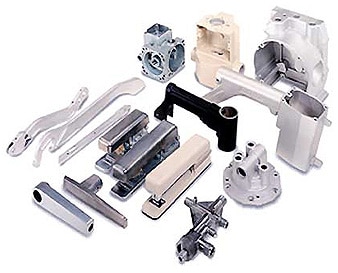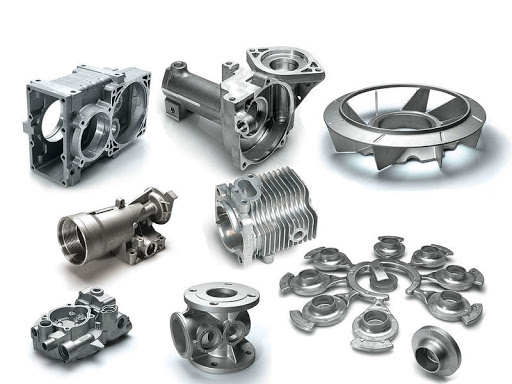Exploring the heritage of Wisconsin Aluminum Foundry in metal casting
Discovering the Versatile Makes Use Of and Applications of Light Weight Aluminum Castings in Modern Industries
Aluminum castings have actually come to be integral to numerous contemporary industries because of their distinct properties. They provide significant benefits in weight decrease, thermal conductivity, and corrosion resistance. From auto developments to applications in consumer products and construction, their flexibility is exceptional. The true level of their effect prolongs beyond instant advantages, hinting at more comprehensive implications for sustainability and effectiveness. What exists in advance for aluminum spreadings in an ever-evolving industrial landscape?
Automotive Market Innovations
The vehicle market has actually increasingly accepted light weight aluminum spreadings to improve automobile efficiency and effectiveness. By utilizing light weight aluminum, suppliers can produce lighter parts, which contribute to enhanced gas economy and minimized exhausts. Key applications include engine blocks, transmission situations, and structural components, where the product's strength-to-weight proportion delivers durability without adding excess weight.
Light weight aluminum spreadings also use premium thermal conductivity, which aids in far better warm dissipation, thereby improving engine performance. Innovations in casting technologies, such as die spreading and sand casting, make it possible for the production of complicated geometries, permitting for ingenious layouts that maximize room and functionality.
The recyclability of light weight aluminum lines up with sustainability objectives in the automobile industry, advertising environmentally friendly techniques. As the sector remains to innovate, the use of light weight aluminum castings is most likely to broaden, driving more advancements in car layout and efficiency.
Aerospace Applications and Developments
While the aerospace sector proceeds to focus on weight decrease and fuel performance, light weight aluminum castings have become a crucial product choice for various applications. Their lightweight nature, paired with high strength-to-weight ratios, enables significant improvements in airplane performance and effectiveness. Aluminum castings are frequently used in structural elements, such as fuselage structures and wing components, where lowering weight is vital.
Current improvements in aluminum spreading modern technologies, including enhanced alloy formulas and precision casting techniques, have actually additionally improved the product's performance abilities. These developments make it possible for the production of intricate geometries and intricate layouts while keeping architectural honesty. In addition, light weight aluminum's outstanding corrosion resistance warranties durability and integrity in rough aerospace settings.
As the aerospace industry increasingly embraces sustainability, aluminum spreadings offer a recyclable option that aligns with green techniques, making them an essential aspect in the advancement of next-generation airplane.
Consumer Product and Everyday Products
As consumers progressively look for lightweight yet sturdy materials for daily products, aluminum castings have acquired popularity in numerous consumer items. The distinct residential properties of aluminum, including its resistance to deterioration and superb thermal conductivity, make it an ideal choice for items like kitchenware, family home appliances, and exterior gear. Light weight aluminum cast pans and pots give also warmth circulation, improving cooking performance. Furthermore, making use of light weight aluminum in things such as bike structures and baggage guarantees an equilibrium in between stamina and transportability. Manufacturers appreciate aluminum spreadings for their adaptability, as they can be quickly molded right into complex forms while maintaining structural integrity. Furthermore, the capacity to reuse light weight aluminum without weakening its residential or commercial properties aligns with growing customer choices for sustainable products. Generally, aluminum castings are indispensable to the manufacturing of durable, useful, and cosmetically pleasing durable goods, meeting the demands of modern-day lifestyles.
Building and Architectural Uses
Aluminum castings have come to be a vital part in building and building style, particularly due to their strength and light-weight nature. These homes make aluminum an ideal selection for different applications, including structural elements, facades, and decorative attributes - Aluminum Castings. Home builders and architects progressively make use of aluminum spreadings for home window frameworks, doors, and roof covering systems, boosting both performance and aesthetics. The material's resistance to corrosion further extends its life-span, lowering upkeep costs and ensuring resilience in diverse environmental problems
Aluminum can be easily built into intricate designs, enabling for cutting-edge building expressions. Its flexibility assists in the creation of personalized items that fulfill particular layout requirements, from ornate railings to complicated supports. As sustainability ends up being a concern, light weight aluminum's recyclability adds to its charm in eco-friendly building practices. Generally, light weight aluminum spreadings are revolutionizing the building and construction sector by giving lightweight, sturdy, and aesthetically enticing solutions.
Electric and Electronic Parts
Light weight aluminum spreadings play an important role in the production of light-weight electrical units, which enhance portability and performance in various applications. On top of that, their excellent thermal conductivity makes them optimal for heat sinks, ensuring peak efficiency and long life of electronic components. In addition, light weight aluminum's conductive homes contribute to its usage in different electrical conductors, stressing its significance in contemporary technology.
Lightweight Electric Units
Lightweight electrical units play an important role in securing sensitive digital components from environmental elements and physical damage. Constructed from aluminum castings, these rooms are valued for their strength-to-weight ratio, making them excellent for different applications across markets. Their lightweight nature aids in lowering total system weight, which is vital in portable and mobile electronics. Light weight aluminum's rust resistance improves longevity, extending the life-span of the encased parts. The capability to mold and mildew light weight aluminum into complicated forms enables for personalized styles, dealing with specific demands while ensuring effective warm dissipation. In addition, these enclosures can be conveniently incorporated right into existing systems, offering adaptability and versatility in modern technological settings. In general, light-weight aluminum units significantly add to the performance of electronic gadgets.
Warmth Sinks and Conductors
While many products are utilized in digital components, aluminum spreadings stick out for their efficiency in heat management as warmth sinks and conductors. Their excellent thermal conductivity enables effective warmth dissipation, which is important in protecting against the overheating of digital gadgets. Aluminum's lightweight nature additionally important link improves its suitability for applications where weight is a considerable variable, such as in aerospace and automotive sectors. Additionally, light weight aluminum spreadings can be quickly formed into complicated shapes, offering layout flexibility for enhancing thermal efficiency. The corrosion resistance of aluminum likewise adds to the durability and integrity of these components in various environments. As modern technology developments and tools become much more compact, the demand for efficient heat monitoring solutions, like aluminum castings, remains to expand.
Marine Market Usage
The marine market increasingly depends on light weight aluminum castings for their extraordinary toughness and corrosion resistance. These residential or commercial properties make aluminum a perfect choice for numerous applications, including watercraft hulls, engine elements, and aquatic equipment. The lightweight nature of aluminum spreadings allows boosted gas efficiency and simpler ability to move in watercraft, which is important for both leisure and industrial vessels.

Light weight aluminum castings also offer considerable price advantages as a result of their lengthy life expectancy and low maintenance demands, minimizing the general functional costs for marine operators. Furthermore, the flexibility of aluminum enables intricate styles that can fulfill particular performance demands.
Producers in the aquatic market use innovative spreading methods to generate intricate forms, making certain that elements fulfill strenuous safety and security and efficiency criteria. As the need for high-performance aquatic vessels grows, aluminum castings are placed as a crucial product in enhancing the performance and durability of marine devices.
Sustainability and Recycling in Aluminum Spreading

Light Weight Aluminum Recycling Refine
Reusing aluminum plays a vital duty in decreasing ecological influence and saving resources within the spreading industry. The aluminum reusing procedure begins with the i loved this collection of scrap light weight aluminum, which can include old elements, making waste, and post-consumer items. This scrap is then arranged, cleansed, and shredded right into small items to facilitate melting.
As soon as prepared, the light weight aluminum scrap is thawed in a furnace at lower temperature levels than primary light weight aluminum production, significantly minimizing power intake. The molten light weight aluminum is then cast into ingots or other forms for reuse in various applications - Aluminum Castings. This closed-loop system enables the efficient recovery of aluminum, protecting its homes while minimizing the demand for virgin materials. The reusing procedure is a vital part of lasting methods in aluminum casting.
Ecological Benefits
While aluminum spreading plays a critical duty in various markets, its environmental benefits are specifically amazing pertaining to sustainability and source conservation. The light-weight nature of light weight aluminum adds to energy effectiveness in transportation, decreasing gas consumption and exhausts. Additionally, aluminum spreading facilitates the usage of recycled products, significantly decreasing the energy needed for manufacturing compared to key light weight aluminum. This recycling procedure lessens waste and reduces the ecological effect connected with mining and refining raw products. Light weight aluminum is 100% recyclable without deterioration of its buildings, promoting a lasting lifecycle. By choosing light weight aluminum spreading, markets can considerably decrease their carbon impact while promoting source effectiveness, making it a vital selection in the pursuit of eco pleasant production techniques.
Closed-Loop Systems

Often Asked Inquiries
What Are the Secret Conveniences of Light Weight Aluminum Castings Over Other Products?
Aluminum castings use lightweight homes, superb deterioration resistance, and high strength-to-weight ratios. They can be quickly molded into intricate shapes, give great thermal and electrical conductivity, and are economical, making them preferable over numerous alternative materials.
How Is the Light Weight Aluminum Casting Refine Environmentally Friendly?
The light weight aluminum casting procedure is eco friendly because of its recyclability, low power usage, and reduced waste manufacturing. Its capability to utilize recycled materials decreases the carbon impact, promoting sustainability within making methods.
What Are Typical Challenges in Aluminum Casting Manufacturing?
Common obstacles in aluminum casting production include keeping dimensional precision, taking care of thermal tightening, protecting against issues like porosity and inclusions, guaranteeing proper mold layout, and optimizing production performance while decreasing material waste and environmental influence.
Exactly How Do Aluminum Castings Compare in Price With Other Manufacturing Techniques?
Light weight aluminum spreadings commonly use affordable expenses compared to other making methods, particularly for tool to high-volume production. Their lower first tooling expenses and effective product use can result in beneficial business economics in time.
What Future Fads Are Expected in Aluminum Spreading Innovation?
Future fads in aluminum spreading technology are anticipated to consist of advancements in automation, boosted alloy make-ups, improved reusing approaches, and the integration of 3D printing, all targeted at increasing effectiveness, reducing prices, and reducing ecological impact.
Recent advancements in light weight aluminum casting technologies, consisting of boosted alloy formulas and look at more info accuracy casting techniques, have further boosted the product's efficiency capabilities. Light weight aluminum spreadings have actually become an important element in construction and building design, specifically due to their toughness and light-weight nature. The light weight aluminum recycling procedure starts with the collection of scrap aluminum, which can consist of old parts, making waste, and post-consumer items. Once prepared, the aluminum scrap is melted in a heater at lower temperatures than primary light weight aluminum manufacturing, substantially lowering energy consumption. Furthermore, light weight aluminum spreading facilitates the use of recycled materials, substantially lowering the energy required for manufacturing compared to main aluminum.